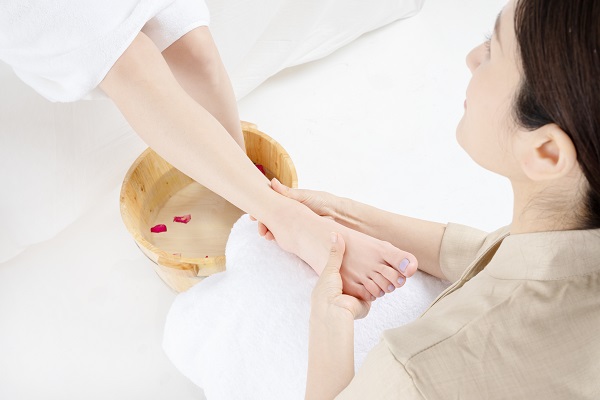To go further, fly higher, one must first learn to take good care of their feet. Foot massage, which can alleviate fatigue and relax the mind, is an excellent way to do this.
Foot massage has a long history in China, and today we will trace the “footprints” of our ancestors to understand this practice better.
Development History of Foot Massage
Foot massage originated in ancient China between 3000 and 4000 years ago. The oracle bones unearthed at Yin Xu have recorded foot massage practices.
Our ancient forebears, often scantily clad and food-scarce, used to dance barefoot around the fire. Over time, they discovered that dancing barefoot on stones could not only relieve fatigue but also alleviate and even eliminate various ailments and pains. This discovery opened a window to the development of foot massage.
During the Spring and Autumn and Warring States periods, the famous physician Bian Que also used foot massage and acupuncture to save the prince of the Guo state from the brink of death.
During the Sui and Tang Dynasties, the development of foot massage reached its first peak. The court set up a specialized massage education department in the Imperial Medical Bureau to train professionals. Later, this technology was spread to East Asian countries such as Japan by diplomatic envoys.
The Ming Dynasty saw the second peak of foot massage. People at this time not only inherited the previous massage system but also first established a foot massage system for pediatrics, laying the foundation for the treatment of pediatric diseases with foot massage in later generations.
Foot Massage Expert Su Dongpo
Su Dongpo, a great litterateur of the Song Dynasty, was not only profoundly accomplished in literature but was also a foot massage expert. According to “The Record of Nourishing Life,” he considered the Yongquan point at the bottom of the foot as the key to nourishment.
Su Dongpo’s method was to first hold his left foot with his left hand and place the right hand’s palm (Laogong point) on the left foot’s sole (Yongquan point), then rub rapidly longitudinally until both the hand and foot generate a warm sensation. He would continue this for about 5-6 minutes and then switch to the other foot. Alternating three times can stimulate the meridian qi circulation in the kidney and pericardium channels, promote blood circulation, clear meridians, and warm and nourish the kidney yang due to the heat from the friction.
Following Su Dongpo’s foot massage method, don’t you feel physically and mentally relaxed? We must not only learn how to do it but also understand why it is done and the principles behind it to continue.
The Principles behind “Su-style Foot Massage”
Su Dongpo’s massage method shows that foot massage works by stimulating acupoints on the foot. Massaging the reflection area of the affected organ or gland restores its original function, achieving therapeutic effects.
Approximately 60 acupoints are collected on the soles of the feet, corresponding to the organs of the human body.
Foot massage can significantly stimulate various parts of the reflection area, facilitating blood circulation, eliminating waste and toxins accumulated in the body, enabling normal metabolism, and ultimately achieving the purpose of treating diseases and maintaining health.
Although foot massage is an effective health method suitable for all ages, long-term adherence can have significant effects on some chronic diseases. However, there are some misconceptions about foot massage that we need to avoid in our daily life.
Three Misconceptions about Foot Massage
Misconception One: The greater the force, the better the effect.
Many people believe that the greater the force applied during a foot massage, the better the result. However, too much force can often be counterproductive. Moderate force is beneficial to health, and the therapeutic effect of foot massage often does not increase proportionally with the amount of force used. Since everyone’s health conditions and physical tolerance levels vary, it’s advisable to apply enough pressure to induce a slightly aching sensation, with a regular rhythm, evenly applied.
Misconception Two: Everyone is suitable for foot massage
Foot massage, which involves stimulating acupoints on the feet to treat diseases or maintain health, has preventive and health benefits. However, it is not suitable for everyone and should be personalized.
Women during menstruation and those with coagulation disorders should avoid foot massage as it can lead to bleeding. Pregnant women, people with high blood pressure, and heart disease patients are at high risk and should avoid foot massage to prevent accidents.
Misconception Three: Home foot massage has the same effect
Many people choose to buy a foot bath and do foot massages at home, considering it cost-effective. However, for a foot massage to work, it must stimulate the corresponding acupoints and apply appropriate force, something that may not be achieved if done unprofessionally at home. Thus, the effectiveness may be less than expected. To achieve better results, it is advisable to have it done by a professional.
Foot massage, with its thousand-year-old history, still prevails today, showing that it indeed has significant benefits for our bodies.
When you’ve had a long day, why not learn from the foot massage expert Su Dongpo and take care of your feet? Starting from today, treat your feet to a massage.
